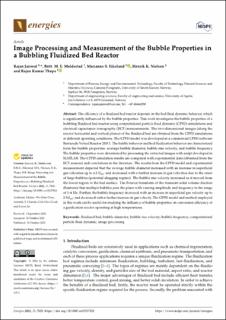| dc.contributor.author | Jaiswal, Rajan | |
| dc.contributor.author | Moldestad, Britt Margrethe Emilie | |
| dc.contributor.author | Eikeland, Marianne Sørflaten | |
| dc.contributor.author | Nielsen, Henrik Kofoed | |
| dc.contributor.author | Thapa, Rajan Kumar | |
| dc.date.accessioned | 2022-12-09T14:31:46Z | |
| dc.date.available | 2022-12-09T14:31:46Z | |
| dc.date.created | 2022-11-25T13:00:47Z | |
| dc.date.issued | 2022 | |
| dc.identifier.citation | Jaiswal, R., Moldestad, B. M. E., Eikeland, M. S., Nielsen, H. K. & Thapa, R. K. (2022). Image Processing and Measurement of the Bubble Properties in a Bubbling Fluidized Bed Reactor. Energies, 15(21), Artikkel 7828. | en_US |
| dc.identifier.issn | 1996-1073 | |
| dc.identifier.uri | https://hdl.handle.net/11250/3037060 | |
| dc.description.abstract | The efficiency of a fluidized bed reactor depends on the bed fluid dynamic behavior, which is significantly influenced by the bubble properties. This work investigates the bubble properties of a bubbling fluidized bed reactor using computational particle fluid dynamic (CPFD) simulations and electrical capacitance tomography (ECT) measurements. The two-dimensional images (along the reactor horizontal and vertical planes) of the fluidized bed are obtained from the CPFD simulations at different operating conditions. The CPFD model was developed in a commercial CPFD software Barracuda Virtual Reactor 20.0.1. The bubble behavior and bed fluidization behavior are characterized form the bubble properties: average bubble diameter, bubble rise velocity, and bubble frequency. The bubble properties were determined by processing the extracted images with script developed in MATLAB. The CPFD simulation results are compared with experimental data (obtained from the ECT sensors) and correlations in the literature. The results from the CPFD model and experimental measurement depicted that the average bubble diameter increased with an increase in superficial gas velocities up to 4.2 Umf and decreased with a further increase in gas velocities due to the onset of large bubbles (potential slugging regime). The bubble rise velocity increased as it moved from the lower region to the bed surface. The Fourier transform of the transient solid volume fraction illustrated that multiple bubbles pass the plane with varying amplitude and frequency in the range of 1–6 Hz. Further, the bubble frequency increased with an increase in superficial gas velocity up to 2.5Umf and decreased with a further increase in gas velocity. The CPFD model and method employed in this work can be useful for studying the influence of bubble properties on conversion efficiency of a gasification reactor operating at high temperatures. | en_US |
| dc.language.iso | eng | en_US |
| dc.rights | Navngivelse 4.0 Internasjonal | * |
| dc.rights.uri | http://creativecommons.org/licenses/by/4.0/deed.no | * |
| dc.title | Image Processing and Measurement of the Bubble Properties in a Bubbling Fluidized Bed Reactor | en_US |
| dc.type | Journal article | en_US |
| dc.type | Peer reviewed | en_US |
| dc.description.version | publishedVersion | en_US |
| dc.rights.holder | © 2022 by the authors. | en_US |
| dc.source.pagenumber | 18 | en_US |
| dc.source.volume | 15 | en_US |
| dc.source.journal | Energies | en_US |
| dc.source.issue | 21 | en_US |
| dc.identifier.doi | https://doi.org/10.3390/en15217828 | |
| dc.identifier.cristin | 2081043 | |
| dc.source.articlenumber | 7828 | en_US |
| cristin.ispublished | true | |
| cristin.fulltext | original | |
| cristin.qualitycode | 1 | |

